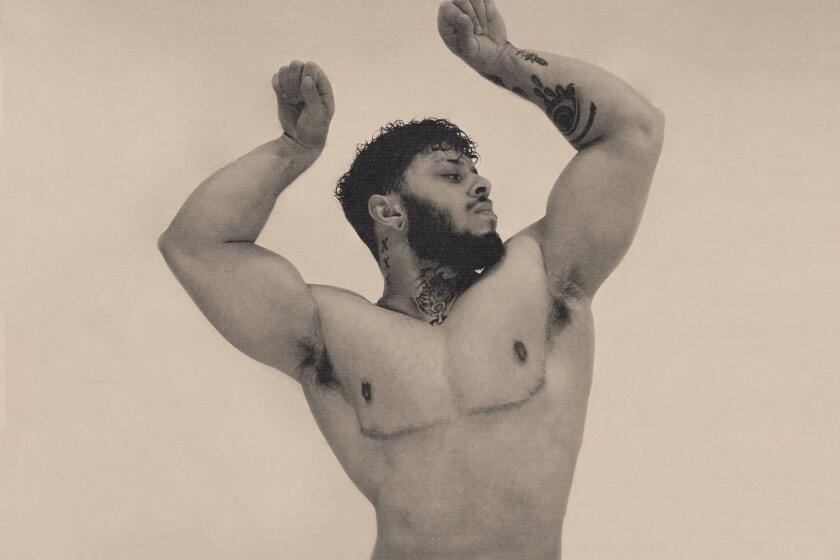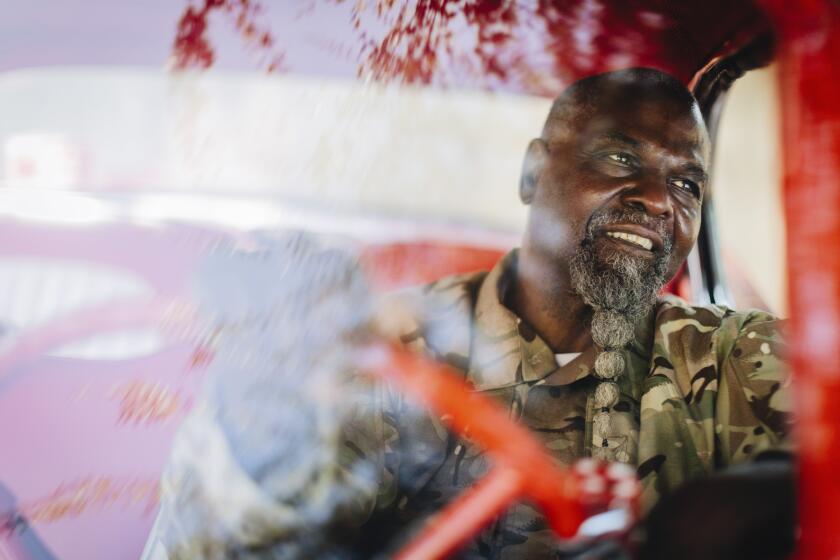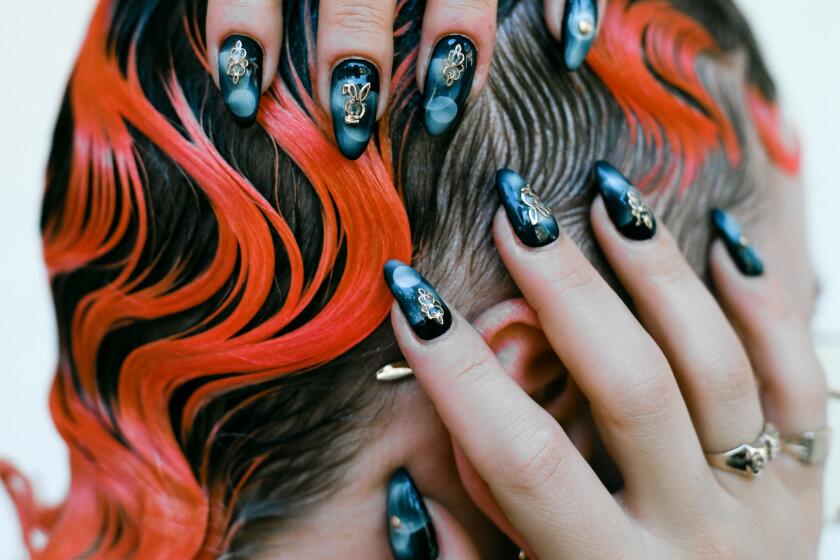- Share via
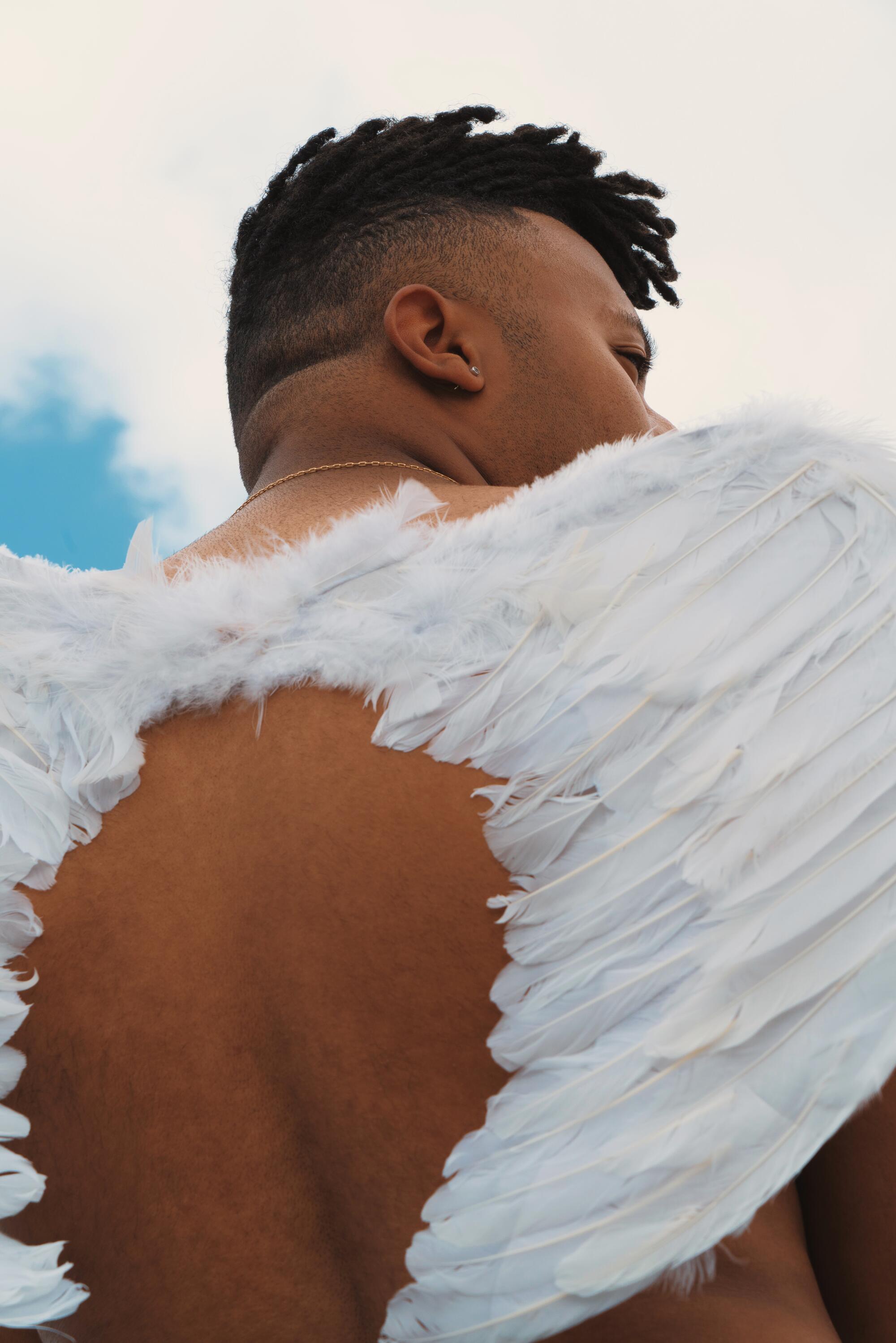
This story is part of Image issue 5, “Reverence,” an exploration of how L.A. does beauty. See the full package here.
Texas Isaiah is a Los Angeles-based image maker from Brooklyn, N.Y. He has taken photos of a range of entertainers, organizers and activists, and close friends — rendering some of the most tender photographs I’ve ever seen in commercial imagery. The group of photographs indexed “personal” on the artist’s website is where I find myself returning to most, however. The eyes of Texas Isaiah’s sitters are often closed, averted, covered or making space for laughter. In others, a person gazes directly at us — not stoic but rather a look that is knowing and gentle.
Sitters in his photos convey what is described as opia: “the intense feeling of invasive arousal that one feels when engaging in mutual gaze.” I consider the trust that’s engendered between photographer and sitter to generate such a look that is deeply interior. The responsibility of a photographer is not only to capture these platitudinous concepts of truth and beauty in artmaking, or the ways in which a subject might see or imagine themselves to be. Too, a photographer has the ability to evidence parts of ourselves that we don’t know or intentionally conceal. The parts of ourselves that don’t satisfy normalized archetypes of how we are perceived by most. On occasion, though, the spill of the interior can be gratifying to share in an environment that welcomes this kind of capaciousness of representation; of what we know on the inside of ourselves, and what is fabricated through the exterior. Texas Isaiah welcomes it all.
Texas Isaiah captured me for the first time in 2020 a few weeks before quarantine began. I felt nervous in advance of our session. As a curator, I prefer to be behind the scenes, not in front of the camera. Like a fleeting moment of enlightenment during meditation, I experienced a wave of peace in front of Texas Isaiah’s camera that left me calm, quiet and comfortable in my person. This is Texas Isaiah’s skill. Not only of technical ability but of heart work, self-awareness and empathy. In recent years, particularly in the last year, since I moved from Detroit to Los Angeles, my friendship with Texas Isaiah has been a refuge for me. A site to feel safe and heard during a time when precarity is so pervasive.
Soon after the harvest moon, Texas Isaiah sat in my downtown apartment (he lives only a few floors below) to talk about his practice as both a photographer and a friend.
Taylor Renee Aldridge: I want to begin by just remarking about how you — as a friend and in your work as an image maker — have allowed me to identify beauty in ways that I haven’t before. Through the sensitivity and consideration of your eye and your spirit, you’re able to capture a certain beauty in your sitters that is vulnerable, sincere and raw. Can you talk about how concepts of beauty inform your practice as an image maker? And also your relationships with loved ones and the way you show up in the world generally?
Image Reverance stories
Mr. Wash remembers that time Drake slid into his DMs
Julissa James unpacks the art of putting someone’s face on your body
Dave Schilling learns what it means to be beautiful in Comme Des Garçons
Jean Chen Ho explores grief through IG thirst traps
Darian Symoné Harvin dives deep into sideburn style
Texas Isaiah: I’ll begin with the second part of the question. My parents have a lot to do with how I’ve been able to form relationships with people. My father is an Aquarius. He used to work at the United Nations. He was always somebody who made me consider what it’s like to think beyond myself. He wasn’t physically present as much early on in my life because he traveled a lot [to] different countries, doing a lot of different missions. I can remember having a lot of resentment toward him because he wasn’t physically present. My mother kind of meets that halfway, with her tenderness and attentiveness toward people. My mom is one of those people that, if I bring anybody over, she’s gonna make them something or have something prepared for them. Her warmth has taught me a lot of patience and understanding. My mother and my father are opposites. I think there’s a balance there; I feel like I represent that balance. It’s definitely informed how I build relationships with people.
Also, [in] east New York — the neighborhood that I grew up in — there were a lot of lessons on what it looks like to not only form relationships but also create boundaries with people. And I picked up a certain type of assertiveness there, for better or for worse. Being able to say what’s on my heart and my mind. Those things are extremely important in how you’re forming relationships with people. I think it gets into the depths of how two people, or multiple people, can love one another. What feels good and what doesn’t. How can I articulate something [in] a situation in which my boundary is crossed? On the other side of that, how can I receive that? What was the first part of the question?
![Rose Quartz [Interlude], 2019 Noel has become a good friend, and we took this image right before he went back to NYC.](https://ca-times.brightspotcdn.com/dims4/default/6d37e6d/2147483647/strip/true/crop/5304x7952+0+0/resize/2000x2998!/quality/75/?url=https%3A%2F%2Fcalifornia-times-brightspot.s3.amazonaws.com%2Ff8%2F34%2Fa8677b114419bf89ffab904c1669%2Fla-photos-freelance-onetime-la-ig-texas-isaiah-x-taylor-aldridge-003.JPG)
TRA: How does it inform your practice as an image maker?
TI: I think about beauty, attractiveness, desirability a lot. I personally don’t fit into those boxes that have already been made for us. And many people in my life also don’t necessarily fit into those boxes that were made by, you know, colonialism, capitalism, etc., anti-Blackness. When I’m in the room, I don’t define who is beautiful and who is not, which we feel very compelled to do. When someone strikes us, you know, it happens. But I’ve been moving away [from] that because I’ve been understanding how, in a lot of ways, that can be ableist, and it can be anti-Black and transphobic, colorist, all of these things. When we are able to detect beauty in one person and not the other person.
A lot of the language within photography is sort of pointed toward the photographer and who do they want to image. I never say no because I’m hung up on the aesthetic presence of a person. Everyone should be imaged if they wish to — if it’s consensual. Whether it’s selfies or hiring a photographer [or] asking friends to photograph them. To ask something like that is really scary. It’s a very vulnerable ask.
Beauty, or what we know of beauty, is so molded. Sometimes I believe I know what it is. Most of the time I don’t wish to understand what beauty is because I think it’s just something that exists beyond us. It may be something that doesn’t exist at all. There’s not a way for me to land at a known because I’m living in a world that’s informed by so many things that are not satisfiable to me.
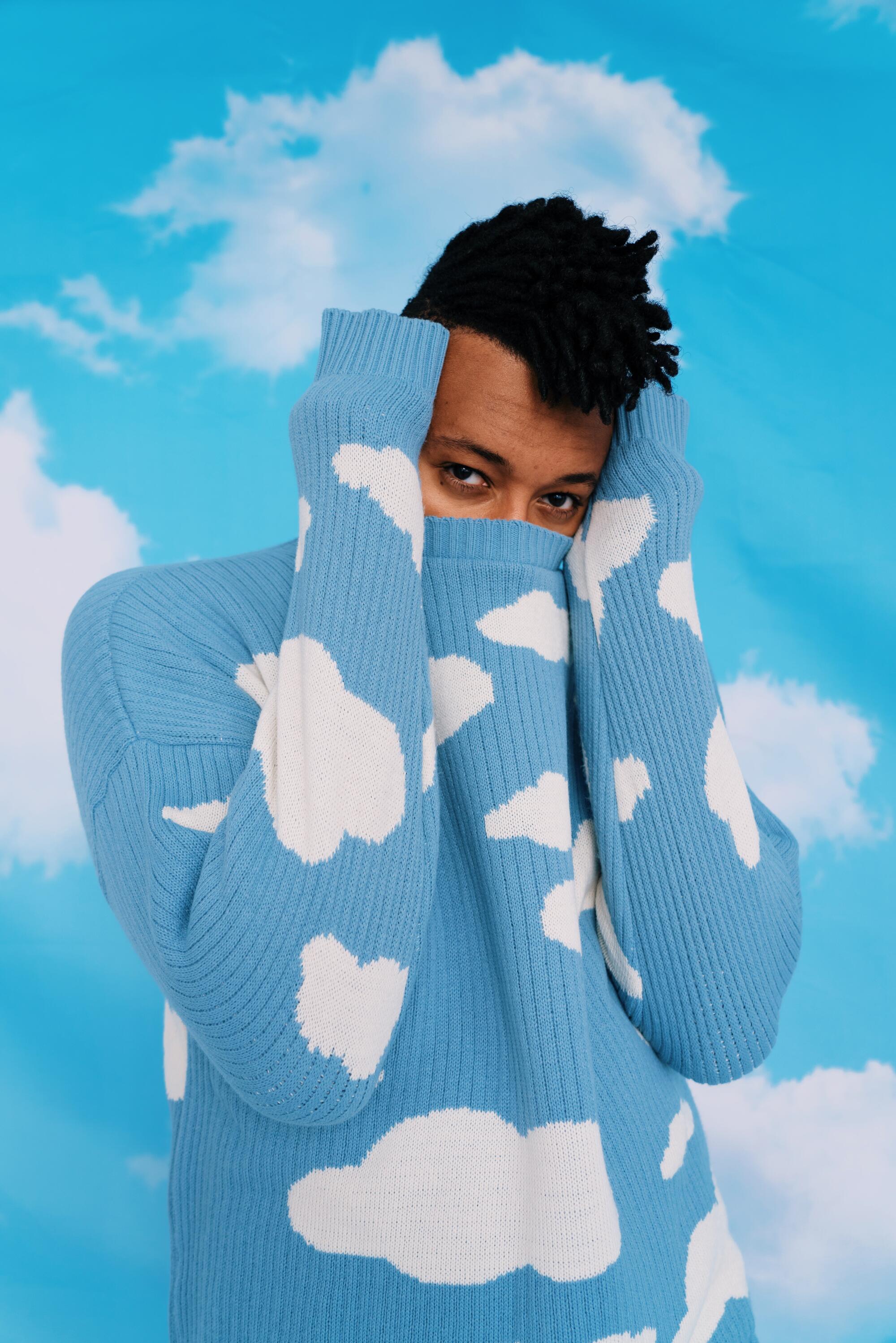
TRA: Thank you for that. As you were talking, I was thinking about how time impacts the way we perceive beauty. In the etymology of beauty, the root of the definition is “something that brings pleasure to senses.” Food is something I derive a lot of pleasure from — specifically, I’m thinking about my engagement with pears lately. I always thought I didn’t like pears. I didn’t think they were beautiful. I wasn’t attracted to them. I didn’t desire them. Recently though, my acupuncturist suggested that I eat pears to improve lung health. When I started eating one, I received so much pleasure from it. It almost overwhelmed me. It was different from what I remembered a pear to be years ago. This aspect of time, right? The sort of misperception — how we might perceive beauty over time — can be easily changed just through exposure, perspective or reconsideration.
Moving onto my next question: I had the pleasure of being one of your sitters. And sitting in front of you and your camera was the first time I felt safe in front of the camera. Looking at the images, once they were completed, it was kind of jarring to see what I look like when I feel safe. It looked totally different from what I knew myself to be. How do you make your sitters feel safe?
TI: The reality of it all is that you can show up in a space with as much attention as you want, but that doesn’t mean that people will automatically feel safe. I’m someone that believes that trust should be earned. I never show up like, “I’m doing a job” or “I’m a photographer to do this assignment.” I’m just showing up as myself. I’m a very observant person. I’m always scanning the environment. Scanning somebody’s body language. I think it helps inform what I say next, what my next move is. I think that’s really important. Being photographed is such a vulnerable process.
Can a body actually turn into a marble statue? Ajay Holbrook will show you how
I’m also very nervous because I understand the weight of it all. There is pressure that I put on myself. I think I greatly understand the importance of the moment — even when the camera isn’t involved, I think, what will somebody say about this experience 15 years from now? I can’t name that everyone has felt safe in front of my camera, but I try my best to be attentive toward people. Reminding people that they have agency within the process can offer some measure of safety.
TRA: It’s so rare in commercial photography — agency and autonomy of the sitter. There’s an essay by Teju Cole about how the history of the photographic device is a tool for imperialism — it was constantly used during colonial projects as a way to capture images of land and conquest. I do want to bring in this aspect of the actual device of the camera and its history and its use as a tool of violence. Obviously it’s been a long time since then. But that lineage is still there. Is there a specific intention or subversive motivation that you bring to image making that considers that history?
TI: I do think about it a lot. I don’t feel like photography is a much-respected medium. But it holds a lot of power — regardless if people recognize it. I’m always thinking about what has been done. Visual narrators have so much more control over the space. To me, being photographed is like inviting somebody into my house — not everyone belongs there. That is informed by the history, because even if people are well-intentioned, that doesn’t mean that their intentions are right.
TRA: Or that the product will reflect its intention, even.
TI: Yeah. Or they’re viewing it as a product.
TRA: Touché. Touché.
TI: It’s a rock and a hard place, because I can have the best intentions in the world but that doesn’t mean that I’m not perpetuating some sort of visual violence, whether in the past, present or future. But the most important thing you could do is just be mindful.
Taylor Renee Aldridge is the visual arts curator at the California African American Museum. She is a Scorpio from Detroit.
